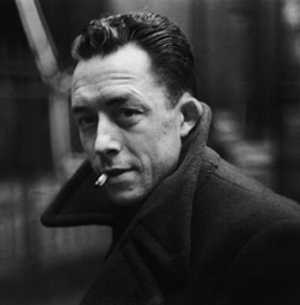|
Three photographs loom large among the things that shaped me as a writer. All of them portray novelists. Two are iconic, one random. Encountered at impressionable moments in my youth, each conjured up a vision of a writer’s life that may have proved mostly false, but still contained enough truth to propel me along my long, strange trip to becoming an author.
The first photo, improbably, was of Mickey Spillane. I came upon it while leafing through a magazine when I was thirteen. It captured the crime novelist standing in his South Carolina beach house. He was a little bullet of a man: cocky, crew cut, bronzed by the sun, wearing sandals and Bermuda shorts. A silver can opener dangled from a chain around his neck. In the background, amid scattered scuba and fishing gear, a beautiful, bikini-clad woman stretched on a sofa, gazing adoringly at the author. There was something dizzyingly seductive about the image, a suggestion that the languorous freedom of childhood could be carried into adulthood, only now with alcohol, spear guns, and hot chicks. “Who is this guy?” I asked my father. “He’s a writer,” he answered, less impressed than me. “What does he write?” “Novels.” “That’s all?” “Yes.” “And this is his house?” “One of them.” I had never really thought much about the people who wrote books. They just sort of existed. That suddenly changed now that it appeared that writers lived in beach houses filled with cool stuff and drank beer whenever they felt like it. This would require further investigation. I discovered my next influential photo as a high school senior. A lot had changed in the four years since my glimpse of Spillane. I’d come to understand that he was something of a hack, that writing was a lot less fun than spear fishing, and that most novelists did not have beach houses. But the residue of that powerful initial attraction persisted. I’d become a passionate reader; I now wrote stories of my own. When a course on existentialism was offered by a teacher I liked, I signed right up. While the novels, essays and plays we read were profoundly inspiring, the images of their authors were not. Ferociously mustachioed Nietzsche looked as if he had been in a bad mood his entire adult life. Wall-eyed Sartre suggested the sort of neighbor your parents urged you to avoid. And craggily ancient Becket brought to mind a headmaster who couldn’t wait to break out the paddle. Was this the price of writing so vividly, so dangerously? Did it twist your features into something pained, even a little grotesque? But then, near the end of the semester, we were assigned Camus’ The Stranger. The author photo portrayed the coolest-looking guy I’d ever seen. Handsome and intense, the collar of his coat popped up to his ears, an unfiltered cigarette dangling from lips that were formed into a defiant half-smile. I kept looking back at him as I tore through his masterpiece, amazed that such a searingly painful book could come from someone who evinced Olympian self-possession and McQueen-like style. Maybe the life I was about to undertake would not exact such a terrible toll after all. I came upon my final photo during my junior year in college, while spending a month in Ireland as part of a course in Irish literature. The highlight was a visit to the Martello tower in Sandycove just outside Dublin, where the great author lived briefly as a young man and where he would later set the first chapter of Ulysses. In the gift shop, I bought a poster of the famous photograph of a young Joyce: hands thrust in pockets, tweed jacket open, cap pulled snug on his brow, head was twisted slightly to the side as if he was sizing up the person looking at him. At the bottom of the poster was the motto pronounced by Stephen Dedalus at the end of A Portrait of the Artist as a Young Man: “Silence, exile, and cunning.” Joyce had been around my age then — 20, 21, — when the photo was taken, just beginning to make the difficult decisions that that would allow him to pursue his profession. The poster hung above my bed during my senior year, when I started to make my own decisions to fly above the nets to become a writer. It would be easy now to dismiss my obsession with these photos as childish folly. Spillane’s work is vanishing like the coastline near a beach house, while most photos show Camus looking more like an affable college professor than James Dean. And I never did get around to reading Finnegan’s Wake. And yet, somewhere in my imagination, these photos live on, their message of freedom, self-reliance and risk still part of my decision to become a writer — a decision I must keep making every day. First published in Biographile Magazine. |
What's going on Archives
July 2024
Categories
All
|

 RSS Feed
RSS Feed